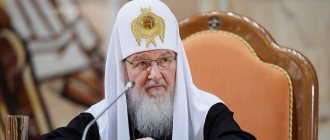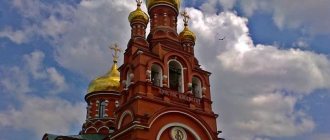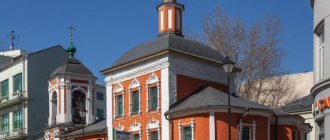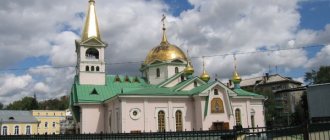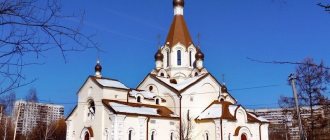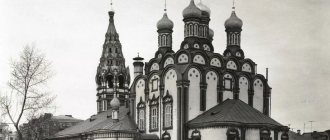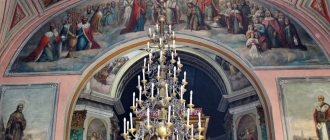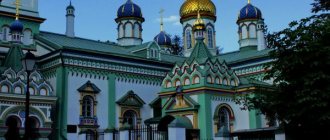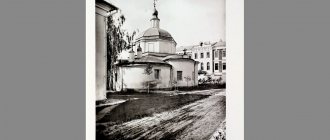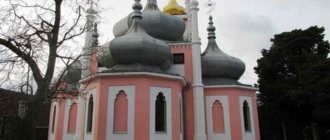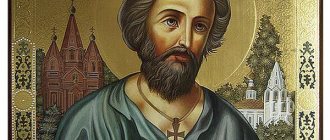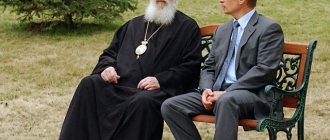Moscow churches are magnificent. Each of them has its own unique architecture and history. The Rogozhskaya side of Moscow is famous for both the Church of St. Sergius of Radonezh and the Church of Alexy of Moscow attached to it.
The Church of St. Alexy of Moscow on the Rogozhskaya side is a Russian shrine built in the mid-18th century; its architectural style was Elizabethan Baroque. The Old Moscow Church is recognizable from afar with its red and white, gingerbread color and golden domes.
Historical information
According to legend, the history of the legendary, dilapidated Moscow church of St. Alexius began with a tent in which the saint stayed, observing the construction of the Savior Andronikov monastery. According to another version, Father Sergius of Radonezh himself watched from a tent the construction of the monastery complex, whose mentor was Saint Andronicus.
Church of St. Alexy, Metropolitan of Moscow in Rogozhskaya Sloboda
According to historical data from 1625, there used to be a small church built of wood on this site. It is further mentioned in 1696, when the consecration of the chapel of St. Nicholas the Wonderworker took place.
In 1701, the stone temple of Alexy of Moscow was presented to the Rogozh side, but the construction of the current shrine dates back to approximately 1750. The parishioners were proud of the shrine of the newly built brick church, the ancient cross transferred from the previous church.
There were 3 chapels in the temple:
- the main one is the holy face of the Mother of God “Feodorovskaya”;
- Alexy Moskovsky;
- Saint Nicholas.
The temple was decorated with a baroque iconostasis. Parishioners came to pray at the holy images of the Nativity and Deesis. Only a quarter of a century later, by 1780, the Sloboda shrine was painted.
Time of destruction and restoration
The Temple of Alexy of Moscow in Rogozhskaya Sloboda after the revolution operated until 1930.
In 1922, the revolutionary authorities, under the guise of fighting hunger, removed 9 grams of gold, about 300 kg of silver and 315 grams of pearls from the treasury. After the closure, the drum with the cross was removed from the Alekseevskaya Church, the bell tower was destroyed, the fence was partially dismantled and extensions were made to place an alloy processing plant in the holy place.
Iconostasis of the Church of Metropolitan Alexei, photo from 1907
In 1984, employees of the repair and construction department sat within the walls of the shrine, and its warehouse was located there.
Return of the Church of St. Alexy of Moscow into the bosom of the Orthodox Church took place in 1990, the main chapel of the Feodorovskaya Mother of God was restored by 2012, but repair and restoration work continues to this day.
Architectural style
The architect D. Ukhtomsky, according to whose design the Church of Metropolitan Alexy of Moscow was built, took the Elizabethan Baroque as a basis. The quadrangle is complemented on the eastern side by an apse, which has a semicircular shape; on the western side there is a three-tier bell tower with a two-limit refectory.
Pilasters and wide cornices add elegance to the walls. Large windows, made in the shape of arches, are decorated with figured platbands; the uniqueness of the windows on the second floor are the broken pediments.
Inside the Church of St. Alexis of Moscow
Architecture of St. Alexis Cathedral
The cathedral building is one large hall, not divided into parts, with side dimensions of 16 and 24 meters. The recessed altar is favorably emphasized by a light-colored dome, which visually increases its volume. Above the entrance to the temple there is an octagon-shaped bell tower. The building itself is made of pale red brick in a rather ascetic style without unnecessary decorative elements. The temple has good acoustics; its spacious choir can accommodate up to 60 singers.
The northern, southern and western facades have voluminous porches, the pitched roofs of which are supported by round twisted columns. The floor of the cathedral is covered with tiles made using special technology. Square cement tiles were filled with colored stone slurry. Their appearance resembles ceramics.
Shrines and patronal feasts
Theodore's image of the Mother of God, according to legend, was written by the hand of the Evangelist Luke.
Previously, the icon was kept in Nizhny Novgorod, showing miracles to the residents of the city more than once. After the invasion of Batu and the flight of the Novgorodians, the shrine left in the church itself appeared in Kostroma in 1239; some Kostroma residents allegedly saw Saint Theodore Stratilates himself bring it to the city.
In honor of the appearance in Kostroma of the shrine of the Alekseevskaya Church, the Orthodox Church celebrates the holiday on August 29. With this icon, Mikhail Romanov, who for a long time did not give consent to reign, but changed his mind in front of the holy image, was blessed to the throne. This is how the second holiday appeared, March 27, the veneration of the holy face of the Mother of God of Feodorovskaya.
The second shrine of the Alekseevskaya Church is the holy image of Simeon the Myrrh-Streaming, whose circle is always crowded. Parishioners come to worship the saint in the hope of miracles, which he performs at the prayerful request of believers.
Important! This is the only Moscow church in which the main chapel is consecrated in honor of the Icon of the Mother of God of Feodorov.
In addition to the veneration of the holy image of the Theodore Mother of God, the following holidays are celebrated in the church of St. Alexis of Moscow:
- February 25 - veneration of Metropolitan St. Alexis;
- May 22 - commemoration of the transfer of the relics of Nicholas the Ugodnik;
- June 2 - commemoration of the discovery of the relics of St. Alexis;
- August 11 - celebration of the Nativity of St. Nicholas the Wonderworker;
- December 19 - St. Nicholas of Myra.
Divine Liturgy in the Church of St. Alexis
Story
The historical beginning of the Temple of Alexy the Man of God is not Krasnoye Selo, but the district of Moscow on Ostozhenka. A monastery of the same name was located in this place, and a small wooden church was erected on its territory in the 14th century. Only the fate of wooden buildings in Moscow at that time was short-lived. The fires mercilessly destroyed both houses and churches, including our temple. Through the efforts of church ministers and parishioners, Orthodox shrines have always been revived and continued their activities. Disastrous events occurred repeatedly. Only in 1633 it was decided to build a stone church. Great importance was attached to this construction due to the fact that Tsarevich Alexei was born into the Romanov family, whose heavenly patron was Alexy the Man of God.
In 1838, it was decided to dismantle the temple and all the buildings of the Alekseevsky Monastery and transport it to a new place, which turned out to be Krasnoye Selo. The former territory was given over to the construction of the Church of All Saints.
Red Village
The settlement has a long history, dating back to the 12th-13th centuries. Documented information about Krasnoye Selo was first left in 1480.
A road passed through this and other villages (Preobrazhenskoye, Cherkizovo), which was called Stromynskaya, as it connected Moscow and the village of Stromyn, from which the road went to Vladimir and Suzdal. It was a pretty busy area.
Krasnoe Selo received its name due to a large pond, the size of which was equated to the area of the Kremlin in Moscow. This pond was called Krasny (meaning Great), which served as the basis for the name of the settlement.
The population in Krasnoye Selo was constantly increasing, which led to the expansion of buildings and the territory of the settlement itself. In the 18th century, Krasnoye Selo increased in size so much that it began to be considered the outskirts of Moscow.
It was to this beautiful place that the Alekseevsky Monastery was moved with all the temples and buildings that belonged to it before the move.
Construction of the temple
The year 1837 became for the Church of Alexy the Man of God a new stage in its renewal and activity. At first, on the allocated territory, the Alekseevsky Monastery was located in the local parish church in honor of the Exaltation of the Holy Cross. In this church there was a chapel of the Tikhvin Icon of the Mother of God. The chapel in the name of Alexy the Man of God at the current church was consecrated in 1841. There was no separate temple yet.
Only in 1853, at the expense of parishioners and patrons of the Alekseevsky Monastery, with the participation of Abbess Ilaria, a warm church was built. This building has survived to the present day from among all the temples belonging to the Alekseevsky Monastery.
The design of the Temple of Alexy the Man of God was developed by the architect M. D. Bykovsky. He developed a plan in which the Alexy Temple was allocated a central place among all the buildings of the Alekseevsky Monastery.
The building had a rectangular shape. The addition of this rectangle was the volume of three semicircular asps, protrusions for the location of altars. In the center of the western facade of the temple there was a projection of the risalit. The top of the temple was occupied by a volumetric dome on a light drum.
The temple was filled with elegant details both from the inside and from the facade of the building, which was its architectural value. To implement his idea, Bykovsky relied on the style of ancient Russian architecture of the 16th-17th centuries.
The interior decoration of the Church of Alexy the Man of God in Krasnoe Selo was distinguished by the wealth of church relics that were donated during the period of its stay in the center of Moscow. The Romanov royal family and many wealthy patrons of Moscow society showed special care for the temple.
In this form, the temple existed until 1899, when the architect Alexander Afanasyevich Latkov reconstructed the monastery stronghold. Some of the open structures were built into the general space of the temple. A sacristy appeared, the basement was equipped for storing church food and utensils, the wooden floor was replaced with slabs (metlakh), a new iconostasis appeared, the author of which was S. L. Konyukhov.
Soviet period
In its updated form, the Alexy Church in the Alekseevsky Monastery conducted church activities until the 30s of the 20th century, until the new Bolshevik government began the destruction of Orthodox shrines, not recognizing the existence of God and any faith.
The Alekseevskaya monastery was destroyed, the churches were closed, including the Church of Alexy with the chapels of the Georgian Icon of the Mother of God and the preacher Paul of Latria. There were other temples located on the territory of the monastery, which were not spared by representatives of the new government. The Church of All Saints was used as an archive, which allowed it to be preserved, and the Church of Alexy the Man of God was converted into the House of Pioneers and rebuilt beyond recognition. Church architectural paraphernalia was removed both from the facade and from the inside of the temple. The walls were repainted red, the altar was converted into a stage, and the central aisle was set up as an auditorium for watching films.
The cemetery at the Novo-Alekseevsky Monastery was destroyed and a pioneer park was built in its place, and later a highway was laid.
Revival of the temple
In the 90s of the 20th century, society realized its wrong attitude towards the Orthodox faith and church shrines, which became the beginning of their revival. The arrival of Alexy the Man of God, at the request of the people and through the prayers of believers and church ministers, also waited its turn. The leadership of the Moscow Patriarchate and people living in Krasnoye Selo and observing its condition applied to the administration for permission to transfer this shrine to the Russian Orthodox Church. A positive decision was made in 1991, which marked the beginning of the revival of the monastery. But restoration work began later, when the temple received its own rector in the person of Holy Father Valery.
In 2000, this man, together with members of his family, entered the abandoned monastery and decided to return it to its proper form. Impressions from what he saw and a list of work carried out in the abandoned church can be studied in excerpts from the diary of Father Valery, published on the page of the official website of the temple.
It was serious work. In November 2002, the first services began, although restoration work continued.
Initially, the Alekseevskaya Church in Krasnoye Selo was attached to the Church of All Saints, but in the spring of 2006, Alexy II, Patriarch of Moscow and All Rus', issued a decree conferring the rank of Patriarchal Compound on the temple. The Church of the Exaltation of the Holy Cross began to be listed as affiliated with the Alekseevsky Church.
The revival of the Church of Alexy the Man of God in Krasnoe Selo became part of the life of its rector, Holy Father Valery, who put his soul, prayers and strength into it.
In 2014, Patriarch Kirill of Moscow and All Rus' consecrated the Alexeevsky Church in honor of the man of God Alexy.
Currently, not only church services are held here, but they are also engaged in the spiritual education of the younger generation. On the territory there is a Sunday school and a club for young people called “Parus”.
